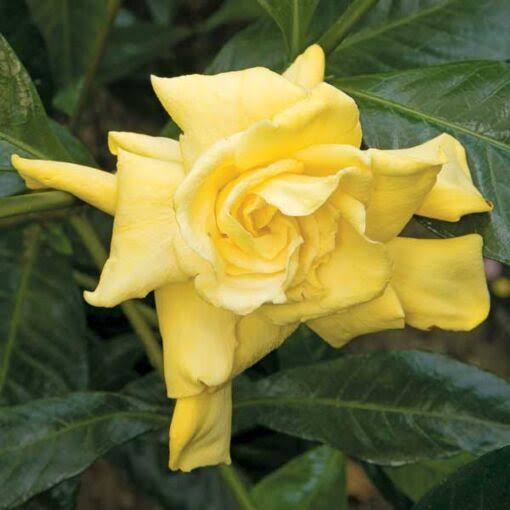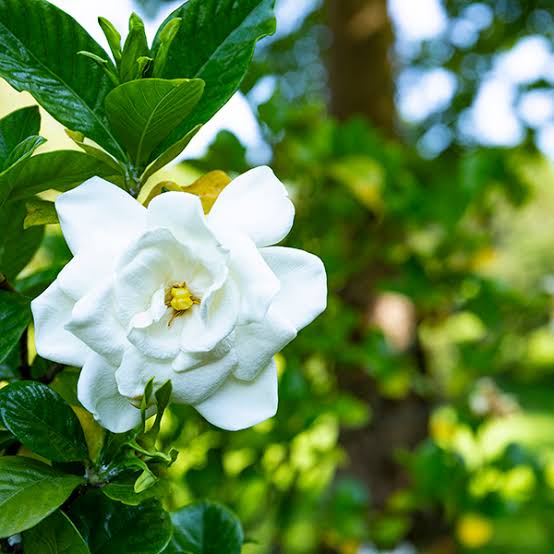The Gardenia flower, with its enchanting beauty and intoxicating aroma, stands as a testament to nature’s artistry. Known for its captivating allure and delicate elegance, this exquisite blossom has long captured the hearts and imaginations of flower enthusiasts worldwide.
Belonging to the genus Gardenia within the Rubiaceae family, these flowering plants are native to the tropical and subtropical regions of Africa, Asia, Madagascar, and the Pacific Islands. Renowned for their remarkable beauty, gardenias have become a beloved choice for gardens, floral arrangements, and perfumery.
One of the most striking features of the gardenia flower is its exquisite appearance. The blossoms typically boast large, creamy white or yellow petals that gently unfurl to reveal a stunning symphony of beauty. The velvety texture of the petals adds a touch of luxury, enhancing the flower’s allure. Furthermore, the glossy, deep green foliage serves as a magnificent backdrop, accentuating the flower’s radiance.
Beyond its visual appeal, the gardenia flower is renowned for its unmistakable fragrance. A single blossom can fill the air with a rich, sweet scent that captivates all who encounter it. Often described as heady and intoxicating, the aroma of gardenia has inspired poets, perfumers, and garden enthusiasts alike. It is no wonder that the flower is frequently chosen to enhance the ambiance of gardens and to create luxurious fragrances.
Cultivating and caring for gardenias can be a rewarding endeavor. These flowers thrive in warm, humid climates and prefer a well-drained soil rich in organic matter. Adequate sunlight, along with regular watering and fertilization, promotes healthy growth and encourages abundant blooms. However, gardenias can be sensitive to harsh environmental conditions, making them a challenge to grow in some regions.
In addition to their aesthetic appeal and intoxicating fragrance, gardenias hold cultural and symbolic significance. They are often associated with purity, love, and grace, making them a popular choice for weddings, anniversaries, and other special occasions. Gardenias have also played a role in traditional medicine, where they have been utilized for their potential therapeutic properties.
Appreciating the beauty of gardenias extends beyond their physical attributes. Cultivating these exquisite flowers can provide a sense of tranquility and a deeper connection with nature. Watching their buds slowly unfurl and their fragrance permeate the surroundings is a reminder of the delicate balance and wonder of the natural world.
Whether adorning a garden, gracing a bridal bouquet, or filling a room with their enchanting fragrance, the gardenia flower continues to captivate hearts with its timeless beauty. It is a testament to the intricacy and elegance of nature, reminding us to pause, marvel, and immerse ourselves in the breathtaking wonders that surround us.
Read Also: Pests of Stored Products and Damages Caused
History And Significance of Gardenia Flower

The history and significance of the gardenia flower are deeply rooted in culture, symbolism, and human connection. Throughout the ages, this exquisite blossom has held a special place in various traditions, arts, and rituals, adding to its allure and timeless appeal.
The origins of the gardenia flower can be traced back to ancient times. Native to regions of Africa, Asia, Madagascar, and the Pacific Islands, gardenias have been cultivated and admired for centuries. They have been referenced in ancient texts, such as Chinese literature and folklore, where they were revered for their beauty and fragrance.
In the 18th century, the gardenia flower was introduced to the Western world by botanists and explorers. It quickly gained popularity among European garden enthusiasts and became a sought-after plant. Its delicate beauty and intoxicating scent made it a prized addition to gardens and greenhouses.
Beyond its aesthetic qualities, the gardenia holds deep symbolic meaning in many cultures. In some Asian societies, the flower is associated with purity, grace, and elegance. It is often used in wedding ceremonies and other auspicious occasions to symbolize love and devotion. In Victorian England, the gardenia was considered a symbol of secret love, conveying messages of affection and admiration.
The gardenia’s fragrance has played a significant role in various traditions and practices. In certain religious ceremonies, the flower’s scent is believed to have spiritual and purifying qualities, helping to create an atmosphere of serenity and reverence. In perfumery, the essential oil extracted from gardenia flowers is highly prized for its complex and captivating aroma, often used as a base note in luxury fragrances.
In addition to its cultural and symbolic significance, gardenias have also found their way into the world of art and literature. Renowned painters, such as Henri Fantin-Latour and Pierre-Auguste Renoir, have depicted the flower’s beauty in their masterpieces. Writers and poets have often used gardenias as a metaphor for love, beauty, and delicate emotions, weaving their essence into stories and verses.
Gardenias have also made their mark in the world of horticulture. Due to their stunning appearance and captivating fragrance, these flowers have become a favorite choice for garden enthusiasts. Numerous cultivars and hybrids have been developed to enhance their beauty and adaptability, allowing more people to enjoy the charm of gardenias in various climates.
However, gardenias hold medicinal and cultural significance in traditional practices. In some cultures, parts of the plant are used for their potential healing properties. They are believed to possess anti-inflammatory, antioxidant, and antimicrobial qualities, making them valuable in traditional herbal remedies.
Today, the gardenia flower continues to inspire and captivate with its timeless charm. Whether adorning gardens, bridal bouquets, or serving as a muse for artists, it symbolizes love, beauty, and the delicate intricacies of the natural world. Its history and significance remind us of the profound connections between humans and nature, and the enduring beauty that can be found in the simplest of blossoms.
Read Also: Collection, Handling, Storage and Pre-Treatment of Seeds
Complete Growing Guide For Gardenia Flower

If you’re enchanted by the beauty and fragrance of gardenia flowers and wish to grow them yourself, follow these essential steps to cultivate these exquisite blossoms and create a thriving garden filled with their splendor.
1. Choosing the Right Location:
Select a suitable location for your gardenias. They thrive in warm, humid climates and prefer a spot that receives morning sun and afternoon shade. Protection from strong winds is also beneficial to prevent damage to the delicate blooms and foliage.
2. Soil Preparation:
Gardenias prefer a slightly acidic soil with a pH between 5.0 and 6.0. Ensure proper drainage by incorporating organic matter, such as compost or peat moss, into the soil. This improves water retention and nutrient availability.
3. Planting:
Dig a hole that is wider and slightly shallower than the root ball of the gardenia plant. Gently remove the plant from its container, loosen the roots, and place it in the hole. Backfill the hole with soil, ensuring the plant is at the same depth as it was in the container. Tamp down the soil gently to remove air pockets.
4. Watering:
Keep the soil consistently moist but not waterlogged. Gardenias require regular watering, especially during dry spells or hot weather. However, they are susceptible to root rot, so avoid overwatering. Mulching around the plant helps retain moisture and regulates soil temperature.
5. Fertilization:
Feed your gardenias with a balanced fertilizer specifically formulated for acid-loving plants. Apply the fertilizer according to the package instructions, typically every 4 to 6 weeks during the growing season. Avoid excessive fertilization, as it can lead to leaf burn or reduced flowering.
6. Pruning:
Pruning helps maintain the desired shape, size, and overall health of gardenia plants. Prune lightly after the blooming period to remove spent flowers and encourage new growth. Avoid heavy pruning, as gardenias bloom on old wood.
7. Pest and Disease Management:
Monitor your gardenias for common pests like aphids, mealybugs, and whiteflies. Treat infestations with insecticidal soap or neem oil, following the instructions carefully. Watch for signs of diseases such as powdery mildew or root rot and take appropriate measures to address them promptly.
8. Winter Care:
In regions with cold winters, gardenias may require additional protection. Mulch around the base of the plant to insulate the roots and cover the shrub with a frost cloth or burlap during freezing temperatures. Alternatively, consider growing gardenias in containers that can be moved indoors during winter.
9. Enjoying the Blooms:
Patience is key when growing gardenias, as they may take a couple of years to establish and bloom abundantly. Once they start flowering, their captivating aroma and exquisite blossoms will reward you with a sensory delight. Cut a few blooms to enjoy indoors or share with others, but leave enough on the plant to enhance its beauty.
By following these guidelines, you can successfully cultivate gardenias and create a breathtaking display of these magnificent flowers in your garden. With proper care, your garden will be adorned with their delicate beauty and alluring fragrance, providing a haven of serenity and natural splendor.
Uses of Gardenia Flowers
Gardenia flowers have been cherished for their beauty and fragrance for centuries, and they find diverse uses in various aspects of human life. Here are some common uses of gardenia flowers:
1. Ornamental Purposes: Gardenias are popular choices for gardens, landscaping, and floral arrangements due to their striking appearance and captivating fragrance. The blossoms add an elegant touch to gardens and provide a visually pleasing focal point. In floral arrangements, gardenias serve as a centerpiece or enhance the overall aesthetic appeal.
2. Perfumery: Gardenia flowers are highly valued in the perfume industry for their rich and intoxicating scent. The essential oil extracted from gardenia petals is used as a base note in luxury perfumes, imparting a sweet, floral, and sensual fragrance. The scent of gardenia is often associated with femininity, sophistication, and romance.
3. Aromatherapy: The fragrance of gardenia flowers is believed to have therapeutic properties and is used in aromatherapy practices. Inhaling the aroma of gardenia essential oil or using it in diffusers and massage oils is thought to promote relaxation, relieve stress, and uplift the mood.
4. Wedding Decorations: Gardenias are a popular choice for weddings, symbolizing purity, love, and grace. They are often incorporated into bridal bouquets, corsages, boutonnieres, and floral arrangements for their beauty, elegance, and fragrance. Gardenias bring a touch of luxury and romance to wedding celebrations.
5. Traditional Medicine: In traditional medicine systems, such as Chinese and Ayurvedic medicine, certain parts of the gardenia plant are used for their potential therapeutic properties. The flowers, leaves, and roots may be prepared as infusions, poultices, or extracts to treat various ailments, including inflammation, infections, and digestive disorders.
6. Culinary Uses: Gardenia flowers have limited culinary applications, mainly in some Asian cuisines. The flowers may be used to infuse beverages, syrups, or desserts, adding a delicate floral flavor and a touch of elegance. It’s important to note that not all gardenia species or varieties are edible, so caution and proper identification are necessary.
7. Symbolic and Cultural Significance: Gardenia flowers hold symbolic meaning in different cultures and traditions. They are often associated with purity, love, beauty, and spirituality. In some cultures, they are used in religious ceremonies, rituals, and celebrations to create a serene and sacred ambiance.
8. Artistic Inspiration: The beauty and elegance of gardenia flowers have inspired artists, writers, and poets throughout history. The blooms have been depicted in paintings, used as motifs in textile design, and incorporated into artistic creations. The delicate petals and enchanting fragrance of gardenias evoke emotions of beauty, love, and tranquility.
From adorning gardens and bouquets to enhancing perfumes and providing therapeutic benefits, gardenia flowers hold a special place in various aspects of human life. Their beauty, fragrance, and versatility make them cherished and sought-after blooms that continue to captivate hearts and inspire creativity.
Read Also: Products That Can Be Derived From Metabolic wastes
